When it comes to motorcycle gear, boots are sometimes treated as an afterthought, deemed optional despite their critical role in rider safety. We perceive full-face helmets, leather jackets, and knuckled gloves as the “Holy Trinity of Gear,” but don’t we also need tall motorcycle boots? After all, it’s the feet that make contact 100% of the time in a crash. The balls of your feet, or your palms, will reach the ground first due to the human reflex to catch oneself in a fall — a result of millions of years of evolution that failed to prepare us for motorcycling speeds.
The need for tall motorcycle boots depends on your riding habits, how frequently you ride, the type of motorcycle you choose, and your skill level, all contributing to the risk-to-reward ratio. Tall motorcycle boots, ranging from 14 to 20 inches in height, cover a larger part of your leg— including the calf—providing better protection against abrasion and impacts, while also safeguarding your lower leg and ankle against twisting and sprains. They also add support for your feet while riding and are designed for all-weather versatility and staying put in a crash.
Tall boots are particularly well-suited for long-distance touring, off-road adventures, sport riding, dirt biking, or flat tracking, where the risk of leg and ankle injuries is significantly more than 50% higher compared to other riding styles. But if your riding mainly consists of short urban commutes or casual rides, short boots may suffice—provided they still meet safety standards—with more comfort and flexibility for everyday wear.
So, preparing for a single ride or embarking on a journey of motorcycle ownership experience can feel a bit philosophical, especially if you consider rich texts on the topic like the phenomenal words of Robert M. Pirsig in his philosophical masterpiece eBook ‘Zen and the Art of Motorcycle Maintenance: An Inquiry Into Values:’
“Some things you miss because they’re so tiny, yet others because they’re so huge.”
Top 10 Best Tall Motorcycle Boots Available Today
Even as you scour online or brick-and-mortar stores in your area in pursuit of the best tall motorcycle boots, take a moment to consider my top picks for the best fit. Scroll right to find buying options, compare prices, and possibly seize exclusive discounts from sellers.
| Boot Model | Category | Full Height (Inches) | Check & Shop Now |
|---|---|---|---|
| SIDI Adventure 2 Gore-Tex | Best Overall | 14.0 in | RevZilla | MotoSport | Amazon |
| Daytona Road Star GTX | Best Sport-Touring | 11.4 in | RevZilla | CycleGear |
| Forma Adventure | Best Adventure | 13.25 in | RevZilla | Amazon |
| Alpinestars SMX 6 v2 | Best Sport | 13.2 in | RevZilla | MotoSport | Amazon |
| Alpinestars Corozal Adventure Drystar | Best All-Weather | 13.5 in | RevZilla | Amazon |
| Dainese Torque 3 Air Out | Best Track Day | 13.1 in | RevZilla | CycleGear | Amazon |
| Alpinestars Tech 7 | Best Off-Road | 14.5 in | RevZilla | MotoSport | Amazon |
| Tour Master Solution 2.0 Air | Best Summer | 11.0 in | RevZilla | CycleGear | Amazon |
| TCX Fuel WP | Best Waterproof | 11.1 in | RevZilla | CycleGear | J&P Cycles |
| Icon Elsinore 2 | Best Vintage | 11.3 in | RevZilla | MotoSport | J&P Cycles |
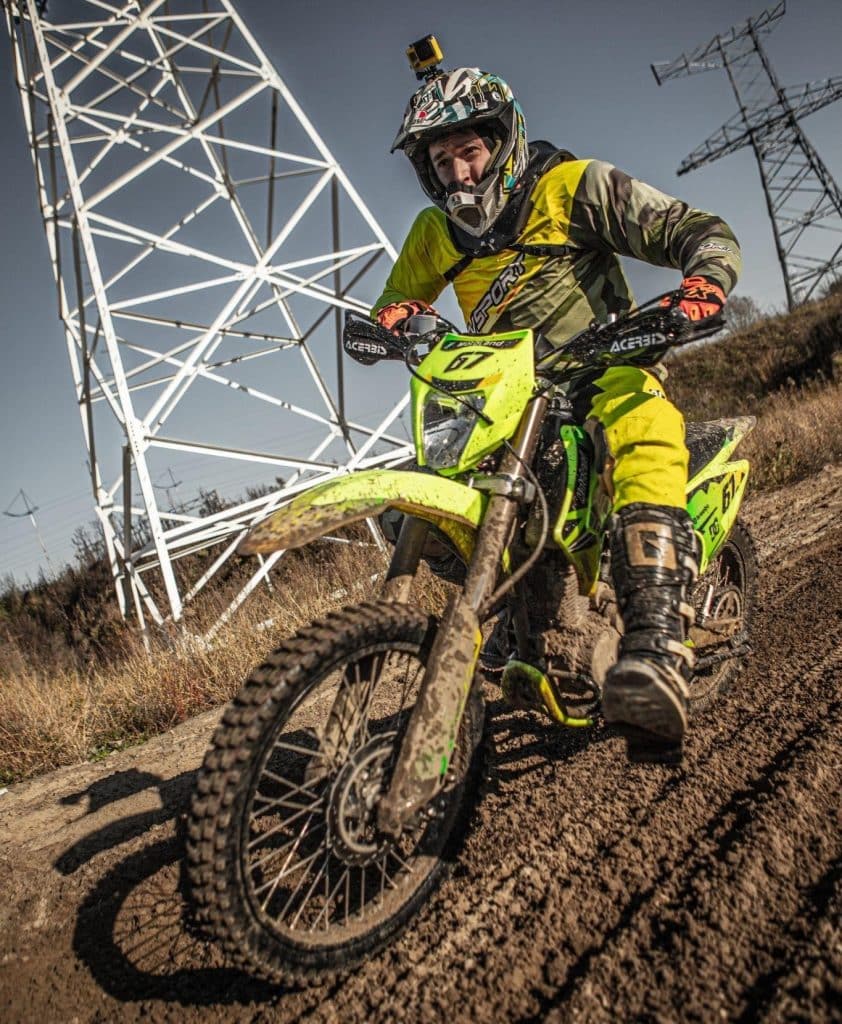
Come now, let’s dissect the tall versus short motorcycle boots dilemma and discover just why a majority of new riders are getting it wrong and how to fix that.
Best 5 Solid Reasons You Need Tall Motorcycle Boots
After 50+ years of riding on two wheels, I’ve witnessed more incidents than most will ever see in a single generation. I’ve lived through a period when motorcycle boots were a rarity—back when bikers vehemently opposed the introduction of helmet laws designed to save lives. Today, I continue to ride in an era where there are plenty of excellent motorcycle boots available, but fewer riders choose to invest in a pair before embarking on a canyon adventure or weekend ride.
And based on the knowledge I have garnered over the years, especially being directly involved in the R&D of said motorcycle boots, here are my five reasons you need tall motorcycle boots:
1. The Most Obvious Is Foot, Ankle, and Calves Protection
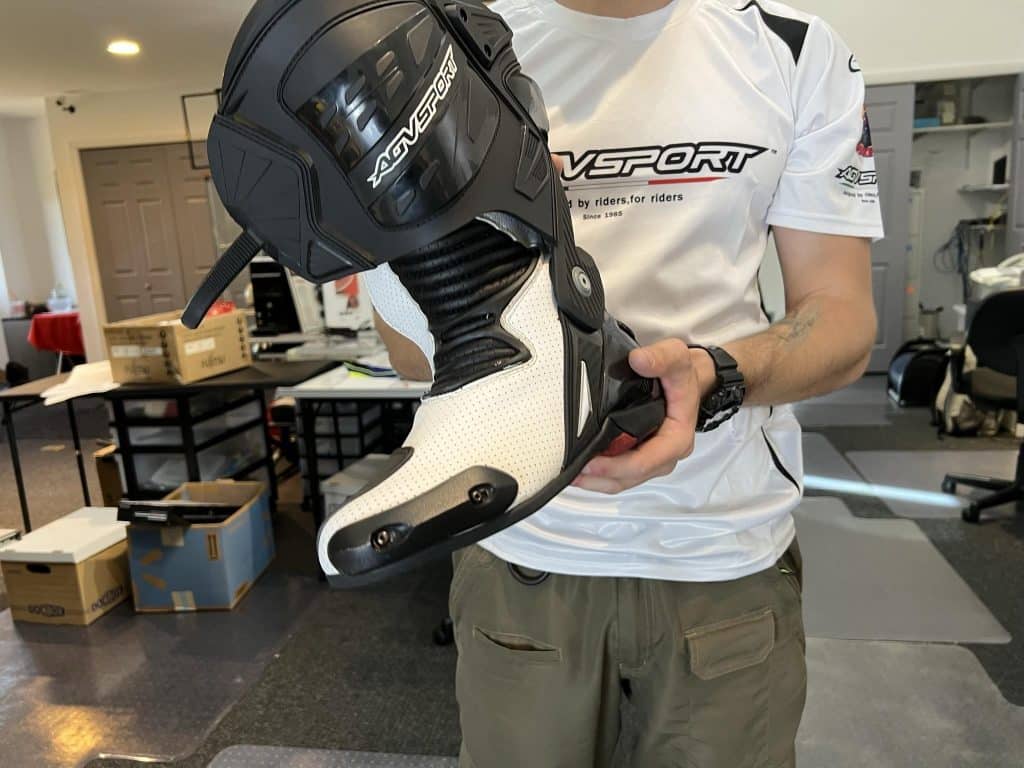
Taller riding boots provide comprehensive coverage, not only for your feet and ankles but also for your calves. Purpose-built motorcycle boots, whether designed for racing on the track, spirited riding on tours, leisurely adventure touring, or intense off-road flat tracking and enduro riding, come with specific features tailored to protect you according to your riding discipline.
For instance, you may have noticed those peculiar metal sliders on the soles of dirt biking boots used in flat tracking (which I highly recommend you try at some point, by the way). Riders rely on these sliders to control the bike through never-ending turns. Without them, the boot would grip the loose surface and potentially send the rider tumbling outward due to centrifugal forces.
Speaking of off-road boots, they differ significantly in size and construction from racing boots. Racing boots are sleek, agile, and robust, whereas off-road boots lean towards a beefier and more articulated design to prevent ankle twisting, which is more common in this style of riding. Then there are ADV (adventure) boots that offer versatility across various riding styles, and sport riding boots, which are less restrictive than racing boots, allowing for more leg movement but offering less torsional protection. Regardless of the boot you choose, it’s a fact that taller boots cover more skin in the event of a crash, providing added protection.
Just a few days ago, the 32-year-old Dutch adventurer Noraly Schoenmaker had to exit the 2023 Dinaric Rally prematurely due to a broken carpal bone after she fell into a ditch. ‘Itchy Boots,’ as she is known to her YouTube followers, had this to say:
“I was going at barely 10 mph while concentrating on my roadbook in an effort to course correct. Without trying to sound cynical, I was lucky that it was just that. If I hadn’t been in proper off-road racing boots, I wouldn’t have been able to manage picking myself and the bike up out of the ditch and covering 50 km to reach the nearest checkpoint for medical aid.”
She heroically did. Kudos to you, Noraly!
2. Improved Stability and Support In The Curves
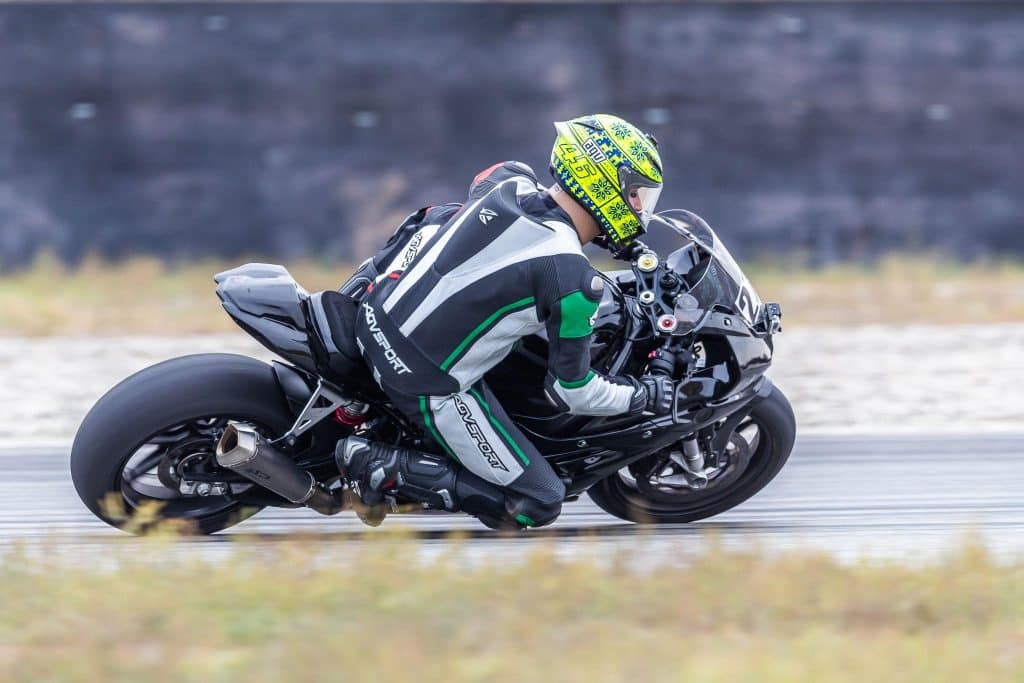
I often say that anyone, be it a monkey or my trusty canine companion, can twist a bike’s throttle and send it rocketing forward. But it’s the art of cornering and braking that truly separates the professionals from the rest. Mastering powerful motorcycles, even as a beginner, demands a steady hand, control, and balance.
In this pursuit, tall riding boots play a crucial role. They instill confidence and enable you to practice sound cornering techniques with minimal fidgeting, offering ample ankle support and a stable foundation on the footpegs. These boots typically have rubber injection molds on the inner side of the foot to enhance grip during corner entry while leaning into the turn. Imagine smoothly transitioning the bike from one lean angle to another for the next corner entry – it’s a slice of riding heaven.
However, this grace can be punishing for your boots as they may collide with hard heel guards, and the teeth on the footpegs can dig in. Here, regular walking shoes fall short. They’re ill-prepared for the demands of motorcycling, their design doesn’t anticipating such rigorous use. Precisely why the soles of motorcycle boots are not merely glued but also sewn on for added strength to withstand the substantial lateral forces encountered during riding.
The marriage of advanced design and in-detail construction in tall motorcycle boots ensures that you can maneuver your bike with finesse, making every turn and stop a testament to skill and control.
3. Taller Boots Are Your Friend When The Weather Takes A Turn
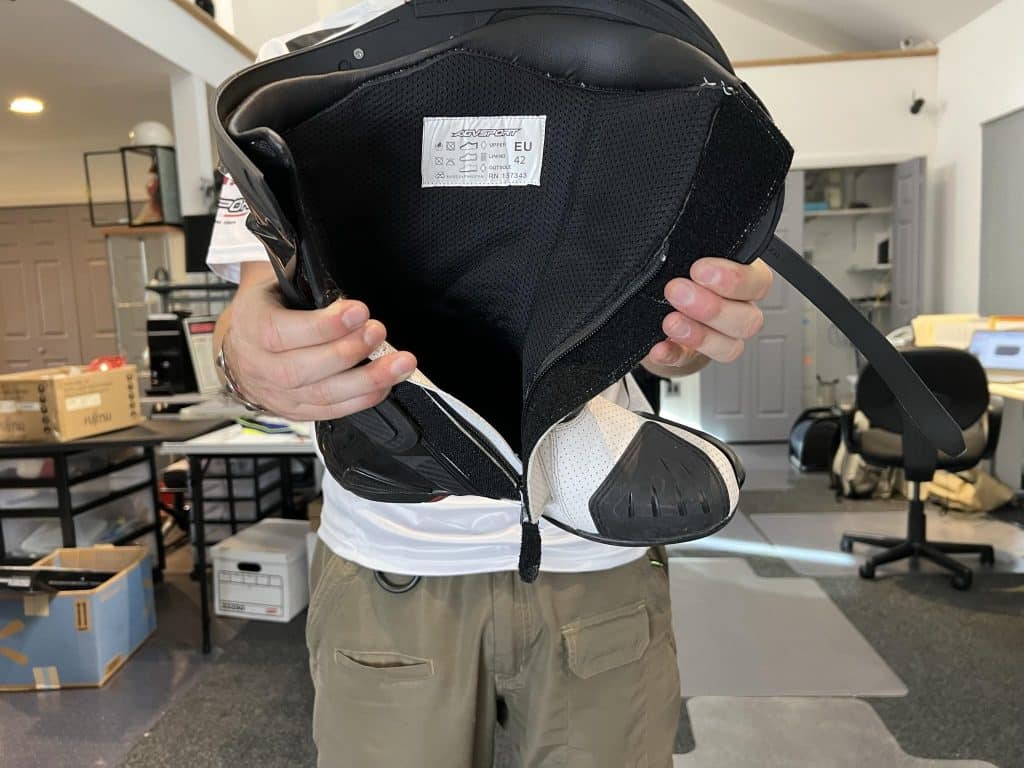
Riding can be as unpredictable as the weather itself, which can suddenly take a turn for the worse. While riding in the rain can be an adventurous experience (up to a point), there are times when you simply want to arrive home with dry feet. Moreover, cold feet can be dangerous as they may fail to respond promptly to your brain’s commands for precise control, potentially jeopardizing your safety.
Taller boots offer better protection against the spray and splatter from your front tire, especially on a naked bike – it’s a straightforward choice, depending on the materials used by the manufacturer, of course.

One common material for achieving water resistance in motorcycle boots is Gore-Tex®, known for its breathability and waterproof properties. If you think about it, there is no such thing as waterproof boots, duh! But these materials come close. Synthetic materials, like Lorica, are naturally water-resistant and can be incorporated into boot designs to keep your feet dry and well-protected.
In colder climates, boots with thermal layers can prevent your lower extremities from succumbing to the cold and freezing up. Dealing with frostbite while riding is painful distracting and can lead to dire consequences on icy motorcycle roads.
4. Stay Visible And Stylish With On Point Graphics
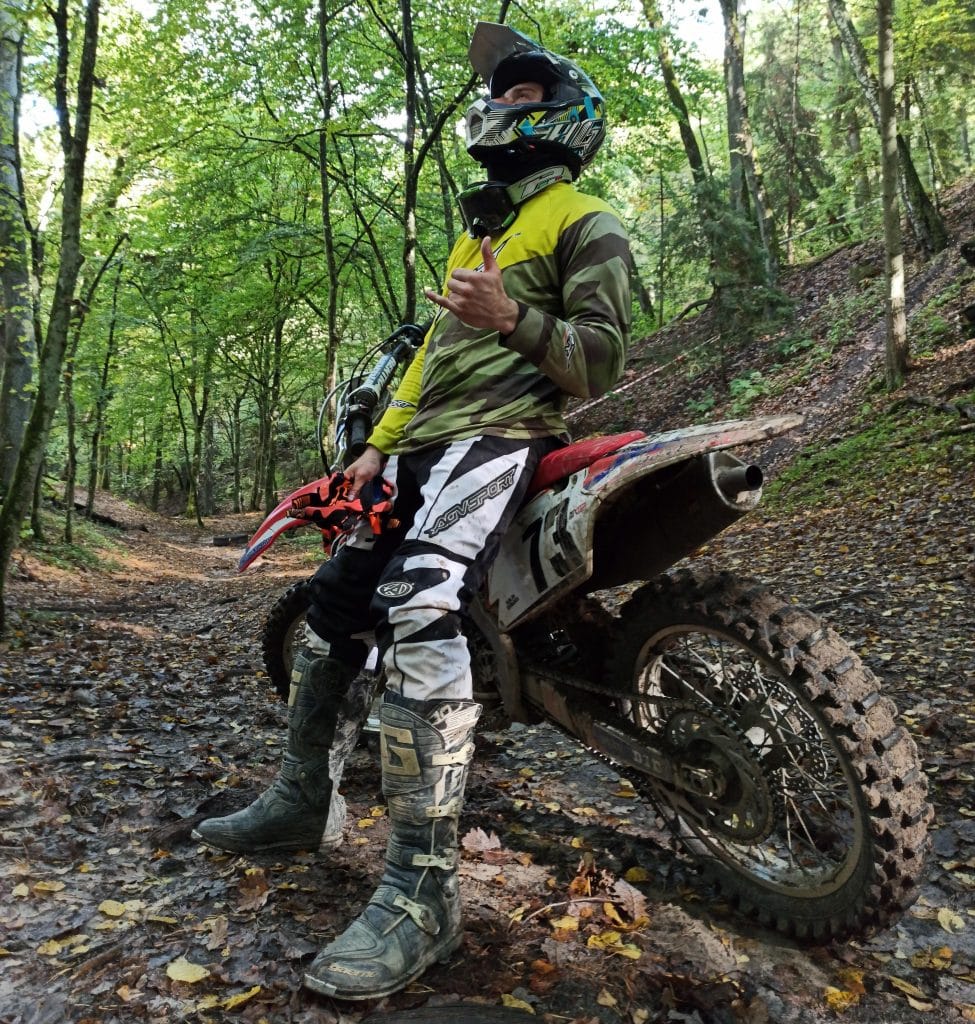
If you are going to be charged an arm and a leg for a pair, then proper motorcycling boots better look the part, and they certainly do. It’s not all for pomp, but manufacturers often use different color schemes to highlight the various features of a boot. Not to say you can’t have your cake and eat it, with professional-grade racing boots in all black, whose presence is only best felt not seen. But overall, I feel that reflective strips and bright graphics on gear aid with visibility, which is a lifesaver in and of itself.
Surprisingly, nearly 70% of motorcycle crashes involving other vehicles occur because the other motorist violated the motorcyclist’s right of way. And you can’t blame them; no one really wants to cause a crash. It’s comparable to a problem pigeons know all too well.
Yes, pigeons! Because at a T-junction, most drivers use only one eye to scan for oncoming traffic, just like pigeons. They have difficulty with depth and speed perception. The fact that motorcycles are narrow with a single reference axis doesn’t help either. But, of course, the biggest culprit is driver inattentiveness. So, whenever you can, make yourself colorful to stay visible, and taller boots have their role, however small, in that.
5. Positive Closure Ensures The Boots Stay On
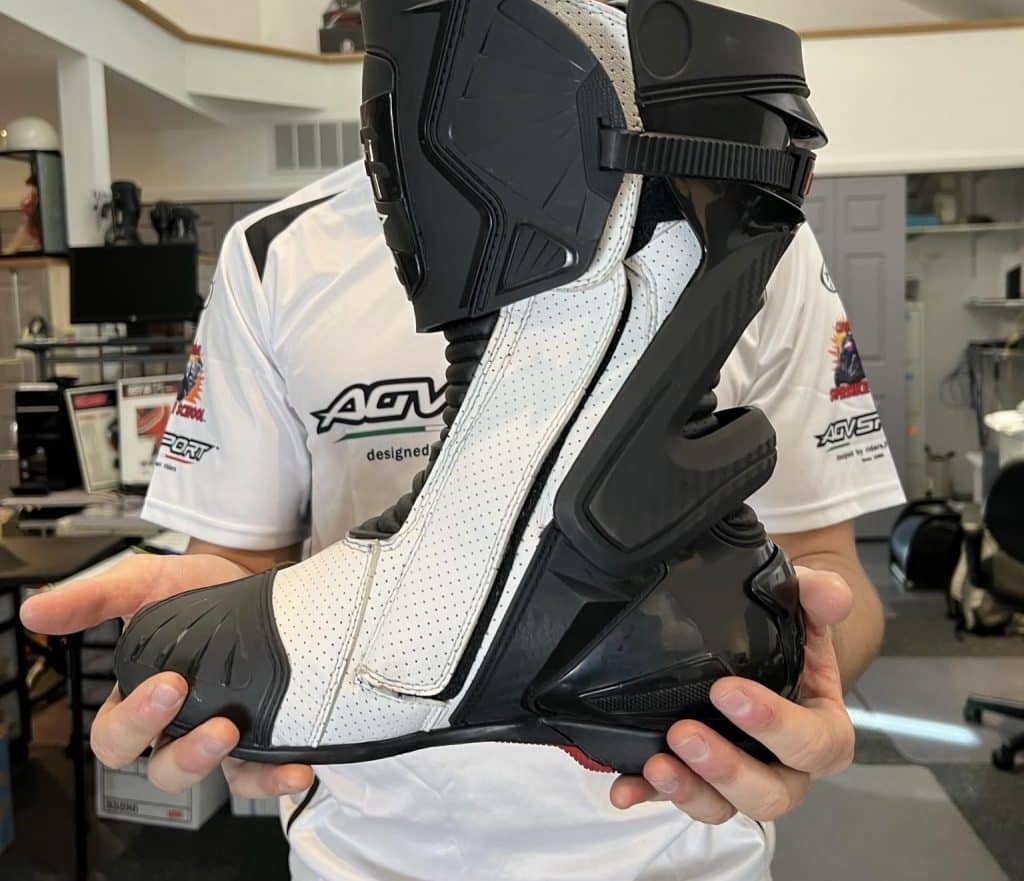
Again, a boot with the best protective technology is only good if it stays securely on your feet in a crash. Taller boots have an advantage in this regard because their secure fit mechanisms are positioned higher up the shaft, reducing the likelihood of them coming off during a crash. But this doesn’t mean sacrificing ease of use. You are getting zippers, laces, buckles, and velcro straps with positive closure – mechanisms that remain shut and cannot unintentionally open.
Now Let’s Find The Achilles Heel Of Tall Motorcycle Riding Boots
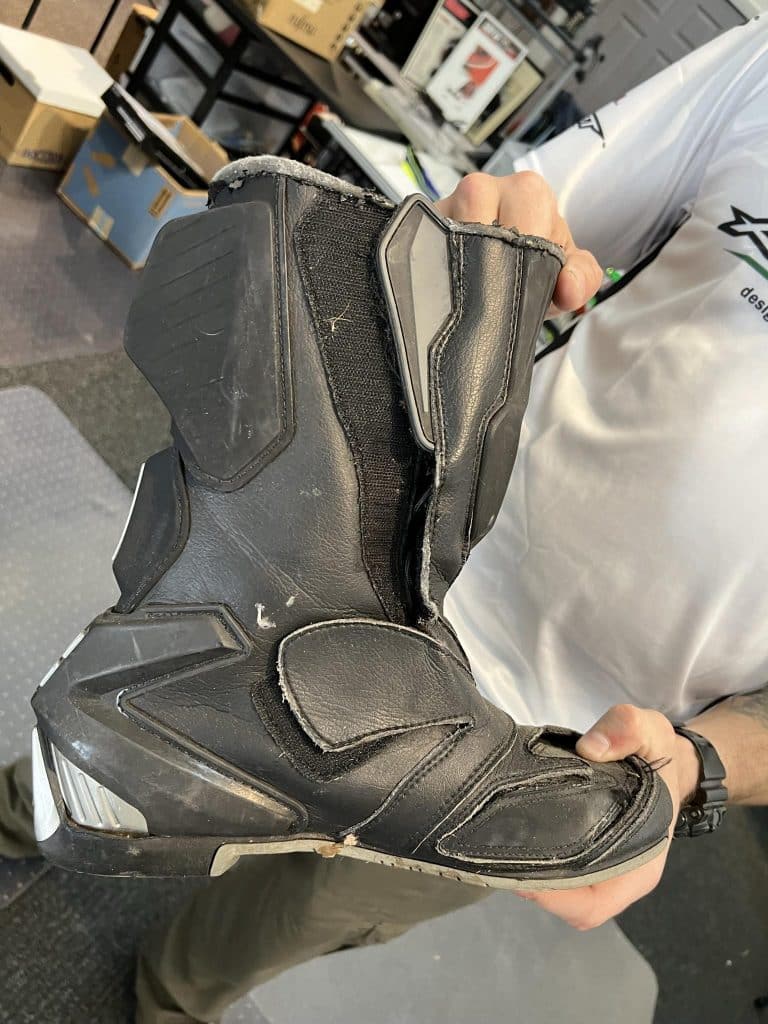
We could go on for days why I consider tall riding boots a worthwhile investment, but they can also be a little:
- Limited Flexibility and Mobility: Taller boots can inhibit normal leg movements, making it difficult to walk around in them. They tend to have more articulated ankle movements for shifting and other maneuvers required to control the bike. Changing over to work or casual shoes and back every time you ride can be tedious.
- Can Be Uncomfortable for Some Riders: Comfortable as they may be for the average five-foot-eight rider, taller boots can be a bit uncomfortable for shorter riders.
- May Require More Time to Put on and Take Off: To an absolute beginner, taller off-road and racing boots can feel a bit fiddly at first because of all the different closures that you have to work with to secure the boot firmly on your leg. But as you get used to it, these boots can start to feel like just wearing your normal work boots, or even easier, depending on the choice of boots.
- May Not Fit Well Under Certain Riding Pants: Are you a pant tucker or a loose legger? You may find that some taller boots have a snug entry, which prevents your leathers from fitting inside the boot with your leg. Be sure to check out reviews of the boot you are aiming to get to grasp just how compatible it will be with some of your other riding gear.
- Limited Walking Comfort And Agility Off The Bike: It is to be expected that, as with racing suits, racing, and off-roading boots are not the most comfortable choice for site inspection or even getting groceries if doing so means walking up a flight of stairs. Restricting natural movements is one-way boot designers try to prevent torn ligaments and sprains in a motorcycle boot. So, yeah, they may not be very practical for everyday commutes as, say, proper work boots or casual motorcycle shoes.
Choose your gear thoughtfully, prioritize safety, and relish every aspect of your riding adventure!
Michael’s Summary and Conclusion
Do you need all types of motorcycle boots? This question should really be divided into two categories: one for road and street use and another for off-road and road racing on tracks.
If you are riding off-road, you definitely need tall boots, and the only way to wear a short boot would be to opt for non-motorcycle-specific boots because all motorcycle-specific off-road boots are tall. On a racetrack, whether racing or participating in a track day, you need a tall race-style boot. A short boot is not acceptable to any sanctioning body and would compromise safety.
So, it’s an easy question to answer: if you are riding any form of off-road motorcycle or riding on a paved track, then you need tall motorcycle boots, period. For street riding on public roads, you have to choose between comfort and maximum safety. If safety is your top priority, just like riding on a track or off-road, you should wear a long-style boot, which offers the most protection. However, these boots can be difficult to walk in and can get hot in high temperatures. Many riders opt for a short-style boot or shoe.
Wearing regular shoes is a bad idea. If you’re not going to wear a long or tall motorcycle boot, at least choose a short-style motorcycle boot that comes up above the ankle to provide protection for your ankle bone. While it won’t protect your shin like a tall motorcycle boot would, a short boot can still offer significant protection to the ankle, joint area, and the lower part of the foot.
FAQs — I Have the Answers!
Q: Do You Really Need Tall Motorcycle Boots?
Yes, you need tall motorcycle boots for long-distance touring, off-road riding, sport biking, dirt biking, or flat tracking. They offer better protection against abrasion, impacts while safeguarding your lower leg and ankle against twisting and sprains. For short urban commutes or casual rides, short boots that meet safety standards can suffice because they’re more comfortable and flexible for everyday wear.
Q: Which Is the Best Tall Motorcycle Boot?
With its 14-inch Gore-Tex gaiter, generous calf space, enhanced grip paneling, and improved ankle flex systems, the SIDI Adventure 2 Gore-Tex is the best tall motorcycle boot available today, suitable for all-weather and on/off-road ADV riding.
Q: How Tall Should A Motorcycle Boot Be?
A tall motorcycle boot should be between 11 to 20 inches in full height, with a specific measurement depending on the intended use and individual preferences. Cruiser and touring boots typically range from 12 to 15 inches for comfort, while adventure and off-road riders may opt for taller boots in the 14 to 20-inch range to enhance protection. For racing and sport riding, 11 to 14-inch boots are common to maintain agility and control at high speeds.
Q: Can I Wear Normal Boots On A Motorcycle?
Yes, you can wear your normal work boots on a motorcycle, especially for short commutes or casual rides, as they’re designed to offer additional safety features such as reinforced ankle support, impact protection, and abrasion resistance, which can help safeguard your feet and lower legs in the event of a motorcycle accident or fall.
Q: Are Motorcycle Boots Really Necessary?
Yes, motorcycle boots are indeed necessary for riders. They provide crucial protection for the feet, ankles, and lower legs in case of accidents, impacts, or road hazards. Motorcycle boots are designed with features like reinforced toes, ankle support, and non-slip soles to enhance safety. They also offer protection from the weather, debris, and hot parts of the motorcycle. Besides, motorcycle boots are specifically crafted to provide optimal comfort and control while riding, making them an essential part of a rider’s safety gear.
Q: What Type Of Boots Do You Need For Motorcycle Riding?
The type of boots you need for motorcycle riding depends on your riding style and preferences. Tall boots, ranging from 11 to 20 inches in height, provide extra protection and are great for touring, off-road, sport, and dirt biking. On the other hand, for urban commutes or casual rides, short boots meeting safety standards can be more comfortable and convenient for everyday wear.
Q: Do You Need Tall Motorcycle Boots For Beginners
Tall motorcycle boots aren’t an absolute necessity for beginners, but they do offer additional protection and are a prudent choice for those who prioritize safety. Short motorcycle boots can suffice, as long as they meet safety standards and provide adequate protection for your feet and ankles. The decision between tall and short boots should take into account your riding style and preferences, with safety being the paramount concern for beginners. The best motorcycle boots for beginners strike a balance between safety and comfort.
Q: How Should Motorcycle Boots Fit?
Motorcycle boots should fit snugly but comfortably, with your toes having some wiggle room while your heel remains firmly against the back of the boot. They should provide good ankle and arch support, secure closures, and meet safety standards for motorcycle riding. Ensure the boots strike a balance between support and flexibility for both riding and walking comfort.
Q: How Tight Should Motorcycle Boots Be?
Motorcycle boots should be comfortably snug, but not excessively tight, ensuring they provide adequate support without causing discomfort. Your toes should have some room to move naturally, and your heel should stay securely in place. My advice is to try on different brands and styles to find the perfect fit for your specific needs and preferences.
Information for this article was partially sourced and researched from the following authoritative government, educational, corporate, and non-profit organizations:
Ni/A












